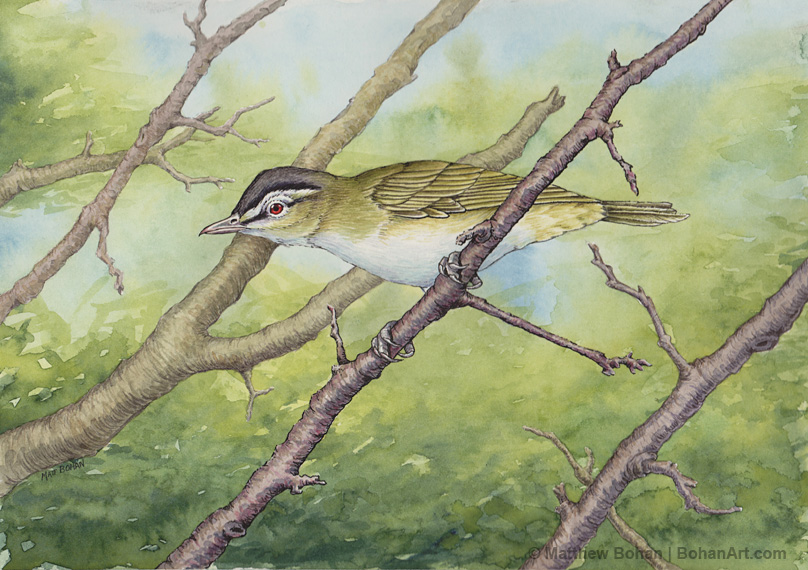Northern Cardinal Pencil Sketch p30
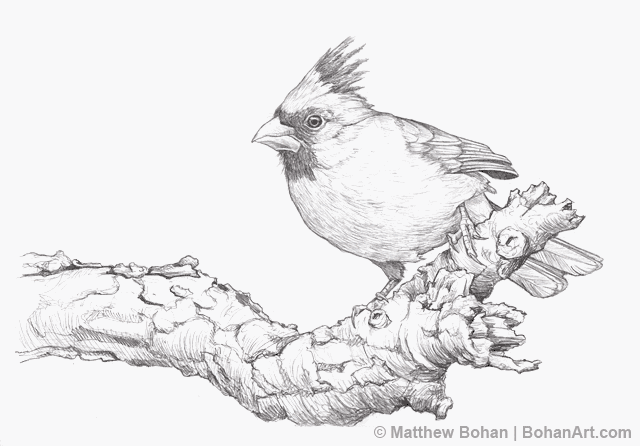
The Northern Cardinal is a fantastic bird. The sight of this brilliant bird on a snowy day is always a welcome sight. That rich red against the stark white of the snow really makes the eyeballs happy. Their beautiful colors and cheery song make them backyard favorites. Almost everyone can identify this guy. I’d imagine that countless birders were inspired to pick up their first set of binoculars after seeing one.
Interestingly, the Northern Cardinal’s bright pigmentation is maintained by eating food rich in various carotenoid pigments! If their diet lacks the proper pigments, their feathers will lose their intense color.
There is an interesting paper on pigmentation in Northern Cardinals and their reproductive success by L. LaReesa Wolfenbarger. The study showed that redder males paired off with females earlier and had territories of higher quality (in terms of vegetation density) than than dull males. The combination of these factors means that redder males produce more offspring in a given year.
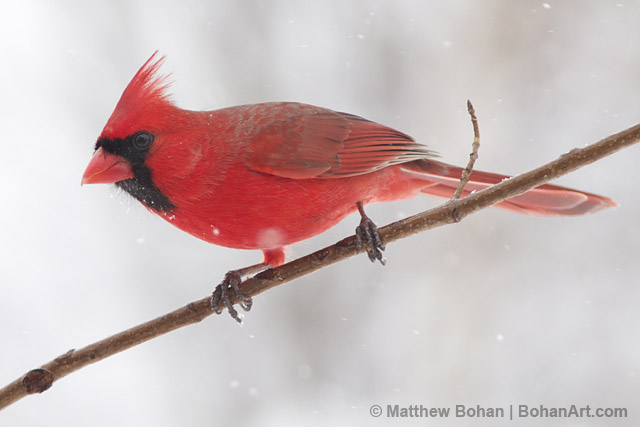
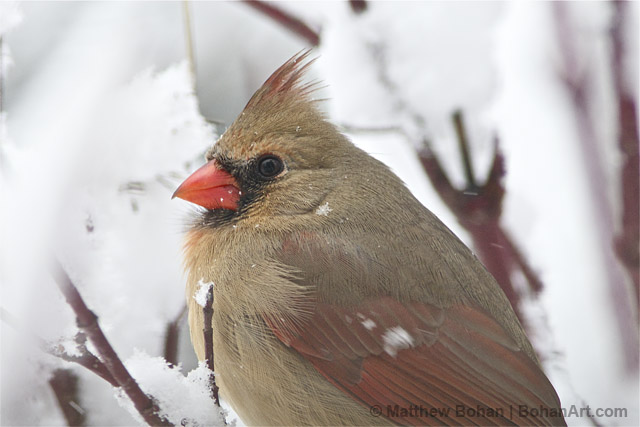
Horses in Snow (Transparent Watercolor)
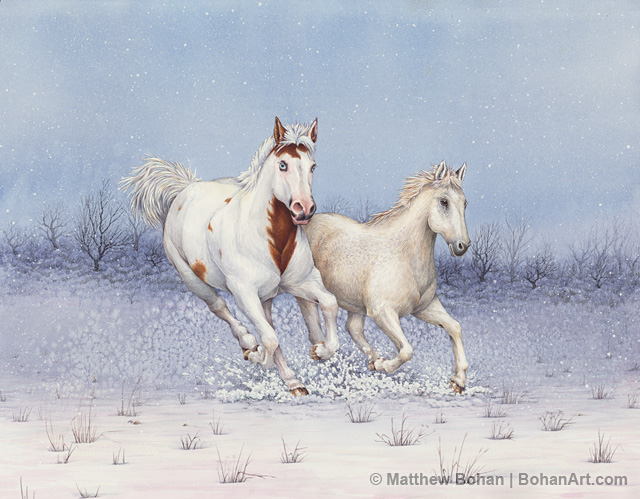
Horses are fascinating and beautiful animals. Early humans were captivated by them, as is evident in many cave paintings. They also were a source of food. The modern horse that we are familiar with is Equus ferus caballus, which is at this point a highly domesticated species. No population of the original “wild type” horses exists. Only the endangered subspecies Przewalski’s horse of Mongolia (Equus ferus przewalskii) has never been domesticated.
Early domestic horses came from the Eurasian Steppe. Eventually they were used for pulling chariots. Most were too small to be ridden. Humans who possessed the horses pulling chariots had a huge tactical advantage over those on foot, which changed world history. Horses were an important part of the earliest Arms Race!
Continued selective breeding allowed humans to breed bigger, stronger horses. The invention of yokes eventually allowed these bigger animals to be used as draft horses. Bits and harnesses allowed humans to ride directly on the horse. This was a huge advantage on the battlefield over armies using chariots. Rider and horse were much more maneuverable. Mounted archers could ride and shoot at the same time. The conquests of the Huns, Vandals and Mongols demonstrate the advantages of mounted soldiers on the battlefield.
Although substantially smaller than the massive horses needed to carry the armored knights of the Crusades, the Arabian Horse gave a tactical advantage to the Muslims due to its great maneuverability. Years ago I read John Keegan’s book “A History of Warfare,” which includes some fascinating facts about horses and their place in world history.
This was a commissioned watercolor done as a Christmas present. Now that it has been delivered to the final recipient, I can finally post it without fear of spoiling any surprises! This painting was a bit of a departure for me. The most stressful part of the project was adding the snowflakes at the end. The painting looked fine without them, but I thought it really needed the falling snow as a finishing touch.
The smallest flakes were sprayed in with an airbrush, while the larger ones consist of white paint flicked off a toothbrush. Over the years I’ve occasionally had an airbrush spatter paint all over a painting and ruin it… and a toothbrush isn’t exactly a precise tool on a good day. After half an hour of tests, I felt confident enough to add the snow—and breathed a huge sigh of relief when everything went as planned. WHEW!


American Red Squirrel Pencil Sketch p29
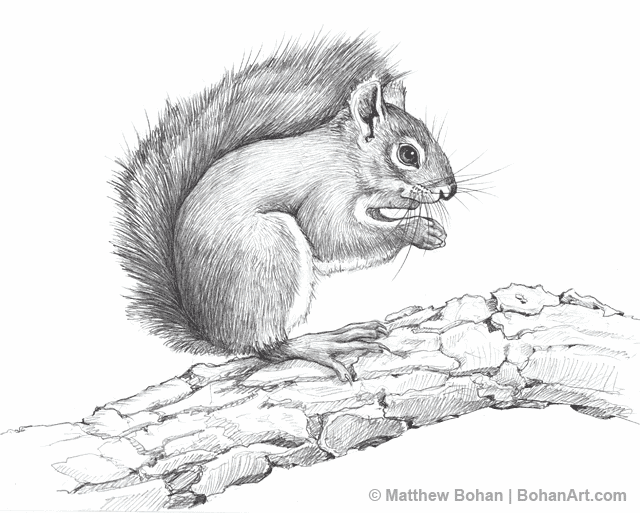
My mother has a real love of nature and animals. She was not one to frivolously shop. However, once when I was a teenager she came home with a something unusual. She opened up a box and showed us her “Find,” which was a life-sized, cast metal Grey Squirrel. It was painted quite realistically and was posed as if it were climbing up a tree. Around our kitchen were a handful of other animal sculptures, mostly small, cute or comical things like a rabbit dressed up as a professional boxer, and another of a rabbit skiing, but this didn’t fit with the rest of the small collection. First of all this was a RODENT, not a lagomorph. Rabbits make for good kitchen decorations because they are cute and, at least historically, they were frequently eaten. A rabbit almost belongs in a kitchen, but a rodent in your kitchen?!? Come on now, that is always bad news, even if it happens to have a bushy tail.
After unveiling the grey squirrel, Mom looked expectantly around for our approval and was met instead with some seriously questioning looks. She had a tough crowd, that couldn’t fathom the purpose of this new discovery. Surely it was too big to use as a kitchen decoration. It was so…real. Not quite a taxidermy mount quality, but edging right up against it. My brothers and I started to make less than serious suggestions about its potential function. Hmmm, perhaps this was intended as a “squirrel decoy” made to charm other squirrels into our lawn. Maybe it was like a scarecrow. We could attach it to the side of the house and use it to frighten the oak trees around our house, keeping them from releasing the torrents of acorns that filled our gutters and kept us awake on windy nights. On the other hand, it could be a lure to bring in hawks or the occasional nefarious bumpkin from the nearby hills that still goes “a-huntin-fer-Skirrul.”
For days that metal squirrel lay on the counter where supplied us with a lot of good natured ribbing. On day we came home from school and it was hung right on the wall of the kitchen. There it stayed for a year or so until it disappeared without mention. Much later, my brothers and I came across it when taking out a box of Christmas decorations in the basement. I wonder where that is now? We still talk about that squirrel on occasion.
This drawing is of a Red Squirrel that has been visiting our bird feeder pretty regularly this year. He is a little too cute, so I have a hard time shooing him away. Rats and mice must hate squirrels. Rats are just one fluffy tail away from a handout.
Now lets get down to business and talk about American Red Squirrels! Growing up in western NY we has mostly chipmunks and Eastern Grey Squirrels, both the grey and black varieties. Upon moving to Michigan, the Fox Squirrel was the most common locally. Red squirrels are somewhere in between the size of Chipmunks and Eastern Grey Squirrels. They are also sometimes appropriately called Pine Squirrels, alluding to their preference for pine and spruce trees and their cones for food. They are feisty and defend their territories aggressively. Their pugnaceous nature is partially due to their food supply. Spruce trees tend to have high yield of cones for a few years followed by a year with very low cone production. The Red Squirrels solve this problem by creating large caches of cones called “middens.” These collections are stored in hollowed logs and other areas, and can contain thousands of cones. That is a pretty precious commodity in a “famine” year, and thus, they protect their territory with great vigor.
Mortality is incredibly high among Red Squirrels. I read that only 22% make it through their first year. Even if they make it through their first year, the average life span of the Red Squirrel is only about 2-3 years with a maximum around 8 years.
Dimorphic Jumper (Jumping Spider) Pencil Sketch p28

Yes, it is yet another jumping spider! I can’t get enough of these little dynamos. I found this little one on a flower and brought it into the basement in the hopes of getting some good macro shots. I really miss seeing these guys during the winter. Every spring I get excited when the first ones show up. Now I’ll bore you with some of the reasons I find jumping spiders so interesting…
This particular specimen is a Dimorphic Jumper. They are named dimorphic from the Latin for “two-forms” because the male and female don’t look alike. Jumping spiders are ambush hunters, using incredible vision to actively stalk their prey. Unlike the more familiar orb weaving spiders, jumpers don’t build a web to live in or to hunt, though they drop safety lines of silk when jumping to protect themselves from injury if something should go horribly wrong. They apparently have more sense than some (human) free climbers! Jumping spiders don’t use silk to wrap their victims, but they use it to construct small tent-like structures to molt and overwinter. Some species also use these structures as a dining room, dragging back their quarry for a peaceful meal.
Jumping spiders are from the family Salticidae, from the Latin word for “jump.” They have amazing leaping abilities, especially when you consider that their athletic feats don’t originate from huge limb muscles like a grasshopper’s legs but rather by the rapid manipulation of hemolymph in their limbs like a hydraulic system. Hemolymph is the arthropod’s blood equivalent, but it is copper based (hemocyanine), rather than iron based (hemoglobin). They truly have blue blood…well, at least when the hemocyanine is oxygenated. Otherwise it is clear. Unlike hemoglobin in vertebrates, the hemocyanine isn’t contained in blood cells; these respiratory proteins travel on their own in the hemolymph through tubes in the spider’s body. Fascinating little critters.
Jumping spiders have fantastic vision. In fact, almost no other arthropod has higher visual acuity. Some great links about jumping spider vision can be found on the Tree of Life Project. Jumpers are daytime hunters relying on their excellent vision to capture prey. It is also critical for finding a mate… without mistaking them for dinner. Most jumping spiders have developed elaborate courtship dances to correctly identify spiders of the same species. It has been shown that some can even see in color! That isn’t much of a surprise since numerous species are so fantastically colored.
Do yourself a favor and check out the Peacock Jumping Spider. It is a perfect example of a truly beautiful spider with spectacular coloration and fascinating behaviors. It’s hard to not think about spiders a little differently after seeing these beautiful and captivating arthropods!
Gray Wall Jumper Jumping Spider Pencil Sketch p27
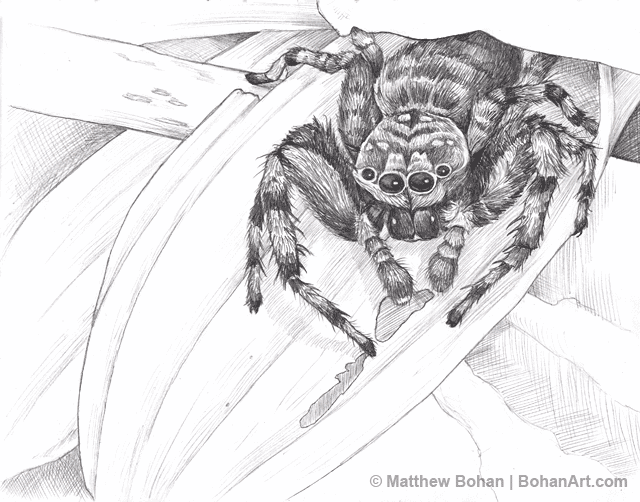
Growing up I was lucky. My parents were into animals and nature. Behind our house we had a huge woodlot to explore, and the other side of the street led to a big field, and past that was a pine forest. The family library was full of field guides, including Peterson’s Field Guide to the Eastern Birds, as well as ones for Wildflowers, Trees and Shrubs, Insect and Rocks and Minerals and more. Those books saw a lot of use. As a child I shared my Dad’s enthusiasm for all sorts of animals like porcupines, the occasional fox and all sorts of birds, but his interest in wildflowers completely baffled me.
My brothers and I would often be brought along on long walks through the hills of southwestern New York. Sometimes we were willing co-adventurers bribed along by the promise of a bottle of Coca Cola, which was a very rare treat in our house. Other times I think we were in forced exile to give my mom a well-deserved break from the escapades of three boys. On many walks we came home only with sore legs without seeing much of interest. On other hikes we’d find something of interest like a garter snake in mid-meal with green frog hanging from its mouth. Often my Dad would stop and look for Purple Gentians, Fringed Polygala or Red Trillium in a place he had discovered them a few years before. That is pretty good for a guy that grew up in a one bedroom apartment in northern Manhattan. Waiting for him while he looked for those flowers sometimes took what seemed to be an eternity.
I remember sitting once on a fallen tree on the ridge of a hill with my brothers. My Dad was off looking for Trailing Arbutis or some other “white whale.” We were taking turns looking through my Dad’s binoculars. While waiting for a peek, I started to peel back some loose bark on the log and discovered a handful of massive grubs of some sort of beetle. They were as large as my thumb. I still don’t know exactly what those were. Dad eventually found his specimen, came back and got a glimpse of the goliath grubs that were writhing around to avoid having the sunlight hit their semi-transparent, soft bodies. He was thoroughly disgusted. Now, it’s hard to gross out a surgeon who was regularly up to his elbows in intestines and enjoyed regaling us with what happened in the operating room in exquisite detail… during dinner. But when it came to insects and spiders, Dad isn’t much of a fan.
While I eventually shared his appreciation of wildflowers, my Dad has never warmed up to the critters that creep and crawl that I find so interesting. This summer I showed him a bunch of photos of wasps and spiders, and he asked why my wife lets me in the house. Another comment he made was “How can you sleep knowing those things are in your yard?!?” Oh well, he isn’t alone. Many people aren’t overly fond of arthropods, but I really find them captivating, especially jumping spiders. They seem to be very cat-like, and some seem downright cute with their big eyes.
Arrow-shaped Micrathena Spider Pencil Sketch p28

I’ve always been interested in insects and spiders, but being small they are very hard to draw from life. Another option is to use dead specimens under a scope, which loses all of the magic of a heathy specimen. Getting into macrophotography has solved many of those problems. A while back I got a great 100mm macro lens and extension tubes for even better magnification. Later, I started experimenting with a triple flash lighting set up. After honing my techniques I’ve been able to get some good photos of really tiny creatures to draw and paint.
This sketch is of an female Arrow-shaped Micrathena spider. I found it on my mother-in-law’s property in Central Tennessee. Although they may look a little creepy to some with the large spikes on it’s abdomen, they are completely harmless to humans. Eventually I need to paint this because black and white doesn’t do them justice. They are beautiful animals with brilliant red, yellow and glossy black all over their bodies. Their Latin name is Micrathena sagittata. Micrathena means “Little Athena,” after the greek goddess Athena who was skilled as a spinner and weaver. The species sagittata is from the Latin word for arrow which describes its pointy abdomen perfectly. You have to like Latin… at least when the names make sense!
White-breasted Nuthatch Pencil Sketch p27
We get White-breasted Nuthatches year round here in Michigan. They are energetic little birds with just the right amount of attitude. A five year old was watching me draw while I was waiting for my kids at karate. I asked her if she knew what kind of bird it was. She looked at the sketch and the photo that I took in the backyard, and quickly said, “That is a Bluebird.” Ha! Well in a way she was right on the money. There is no denying that it is a “blue bird.” OK… maybe more “blue-grey”, but there is a lot of blue in there. After she said that I keep noticing just how bluish they really are. Kids really make you see things in different ways.
We have ton of feeders around the house. Most of them are located by the kitchen window where we homeschool. Last week the local Cooper’s Hawk came in to dine on the birds at our feeder. Most of the potential victims exploded off in every direction to escape. Two birds didn’t manage to quite get away. A chickadee flew toward out window and ended up grabbing onto the screen, and a female White-breasted Nuthatch stayed frozen on the log I have drilled out and filled with suet. The Cooper’s followed some of the birds to the white spruce only 15 feet away. The two birds kept motionless for what seemed an eternity. Finally, the chickadee couldn’t hold onto the screen anymore, gave up and flew off to safety while the Cooper’s looked the other way. That little nuthatch looked like she was stuffed and stapled to the log, not moving a millimeter. Eventually the Cooper’s gave up and flew off. The nuthatch was not about to be easily fooled! Minutes later, birds started to return to the feeder now that the threat was long gone, yet that little nuthatch stayed plastered to the log for about twenty minutes before it shot away. It pays to be safe.
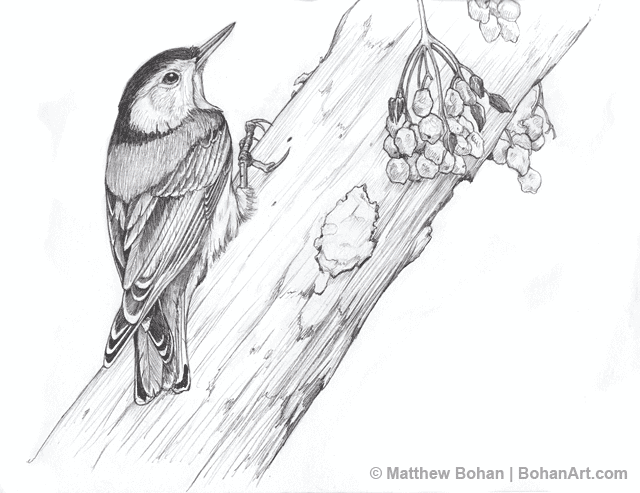
Eastern Box Turtle Pencil Sketch p26
I found my first Eastern Box Turtle in January of 1989. It was a Florida subspecies. What a fantastic experience that was. At the time I was in grad school and was a Teaching Assistant for a course on Ecology of the Everglades. We found all sorts of great things on that trip including indigo snakes, pygmy and diamondback rattlesnakes, cotton mouths, and a myriad of great birds. I’ve seen Eastern Box Turtles many times since, but it always makes my day when I come across one. I’ve always lived outside their normal range and came across them only while on trips.
I found the female box turtle in this sketch while visiting family in Tennessee. It was my kid’s first experience with one in the wild. It was a real thrill for them. Although she didn’t seem particularly big, the turtle in the drawing was about 20 years old. You can approximate the age by counting the growth rings on the turtle’s carapace. As they get older the rings wear down and it is hard to be very exact. Box Turtles can live up to fifty years!
Determining the gender of a box turtle is pretty easy if they are in your hand. Flip it over and look at the plastron (the hard “shell” of its abdomen). If there is a good sized depression, then you have a boy. If you can’t get your hands on it to flip the turtle over, the males have a flatter carapace (top shell), longer, wider tails, and red to orange eyes. The eyes of the females are more yellow-orange to brown. Honestly, I’ve never been that good at determining them by the eye color or carapace because there is so much individual variation.
Box turtles have hit hard times. They have very long lives and correspondingly slow reproductive rates. Pairing that with habitat loss, over-collection for the pet trade, increased predation from raccoons, road kills and other factors lead to a declining population. Hopefully we can figure a way to keep these great turtles around. In the words of one of my all time favorite professors, Doc Bothner, the Eastern Box Turtle is “One Classy Herp.”
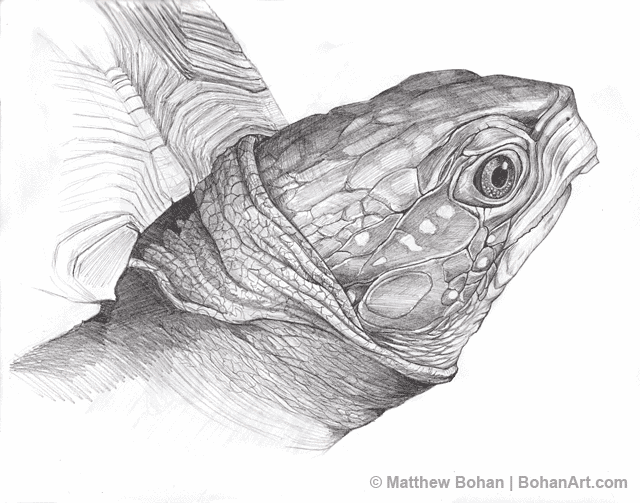
American Tree Sparrow Pencil Sketch p25
Most sparrows don’t seem very dramatic at first glance. From a distance the majority seem to be generic little brown-gray birds. With time and a nice set of binoculars, the sparrows really come to life. You get to appreciate how pretty many of them really are. Sure, they don’t have all the dramatic colors of a Magnolia or Cerulean Warbler, the sparrows are full of subtle beauty. Most are a symphony of brown, grey, creams and whites. Each type have patterns and different color accents of black, white, rust, yellow to set themselves apart.
In Michigan the handsome rusty-capped American Tree Sparrows frequent our yard throughout the winter. They get replaced by the similar-looking Chipping Sparrows as the warmer weather moves in and the Tree Sparrows travel to the tundra to nest. American Tree Sparrows are bigger and have longer tails than the Chipping Sparrows. They also have a dark spot on their breast, a rusty eye stripe, and a black and yellow bill. Seeing the winter birds, like the American Tree Sparrow, return to the yard in the Fall always makes up for the lack of leaves and the cold weather.
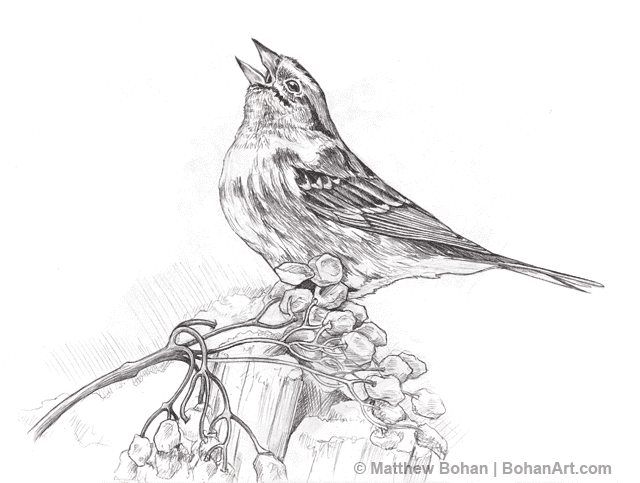
Red-eyed Vireo Transparent Watercolor and Ink Step-by-step
Although the red-eyed vireo is a common bird, most people aren’t very familiar with it. It is well camouflaged and prefers staying high in the woodland tree tops where it sings incessantly. To my ear its call is akin to the American Robin’s, but one that happens to be a blabbermouth. The vireos are similar to the wood warblers being smaller birds that eat mostly arthropods.
Typically I find red-eyed vireos skulking around in the tree tops in the spring. Once the leaf cover is full they get very hard to find. Despite the “motor mouth,” their olive colors keep them well hidden. The past few years we have had Red-eyed Vireos come down to eye-level right outside our kitchen window in the late summer/early fall. I think they are coming in to eat the dogwood sawfly larvae on the dogwoods near the house. I’ve managed to get a few shots of these gorgeous birds over the years when they are nice and low. This ink and watercolor painting was done from some of those photos.
